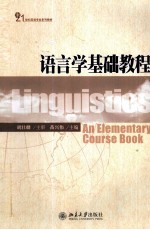图书介绍
语言学基础教程【2025|PDF下载-Epub版本|mobi电子书|kindle百度云盘下载】

- 苗兴伟编著 著
- 出版社: 北京市:北京大学出版社
- ISBN:9787301138397
- 出版时间:2010
- 标注页数:238页
- 文件大小:11MB
- 文件页数:251页
- 主题词:语言学-高等学校-教材
PDF下载
下载说明
语言学基础教程PDF格式电子书版下载
下载的文件为RAR压缩包。需要使用解压软件进行解压得到PDF格式图书。建议使用BT下载工具Free Download Manager进行下载,简称FDM(免费,没有广告,支持多平台)。本站资源全部打包为BT种子。所以需要使用专业的BT下载软件进行下载。如BitComet qBittorrent uTorrent等BT下载工具。迅雷目前由于本站不是热门资源。不推荐使用!后期资源热门了。安装了迅雷也可以迅雷进行下载!
(文件页数 要大于 标注页数,上中下等多册电子书除外)
注意:本站所有压缩包均有解压码: 点击下载压缩包解压工具
图书目录
Chapter 1 Language and Linguistics1
1.1 What is language?1
1.2 The design features of language3
1.3 The origin of language4
1.4 What is linguistics?5
1.5 The scope of linguistics7
1.6 A brief history of linguistics9
1.6.1 Saussure as the father of modern linguistics9
1.6.2 American structuralism10
1.6.3 Generative linguistics11
1.6.4 Functional linguistics12
Questions and Exercises13
Chapter 2 Phonetics and Phonology:The Sounds and Sound Patterns of Language14
2.1 Introduction14
2.2 Phonetics14
2.2.1 Speech organs15
2.2.2 Consonants16
2.2.3 Vowels18
2.2.4 Transcription of speech sounds20
2.3 Phonology21
2.3.1 Phoneme21
2.3.2 Phone and allophone22
2.3.3 Phonotactics23
2.3.4 Prosodic features:stress,tone and intonation25
2.3.5 Co-articulation effects26
2.4 Summary27
Questions and Exercises28
Chapter 3 Morphology:The Word Structure of Language29
3.1 Introduction29
3.2 The words of language29
3.3 The structure of words30
3.4 Morpheme,morph and allomorph31
3.5 Classification of morphemes32
3.5.1 Free morphemes and bound morphemes32
3.5.2 Roots and affixes32
3.5.3 Inflectional morphemes and derivational morphemes32
3.6 Word formation processes33
3.6.1 Derivation34
3.6.2 Compounding35
3.6.3 Conversion37
3.6.4 Blending37
3.6.5 Backformation38
3.6.6 Abbreviation or shortening38
3.7 Summary39
Questions and Exercises39
Chapter 4 Syntax:The Sentence Structure of Language41
4.1 Introduction41
4.2 Sentence structure42
4.2.1 Definition of sentence42
4.2.2 The linear structure of sentence42
4.2.3 The hierarchical structure of sentence43
4.3 The traditional approach43
4.4 The structural approach45
4.4.1 Immediate constituent analysis45
4.4.2 Endocentric and exocentric constructions46
4.5 The transformational-generative approach47
4.5.1 The TG model of grammar47
4.5.2 Syntactic structure49
4.5.3 Movement56
4.6 The functional approach61
4.6.1 Functions of language61
4.6.2 Functional analysis of syntactic structure63
4.7 Summary64
Questions and Exercises65
Chapter 5 Semantics:The Meaning of Language67
5.1 Introduction67
5.2 Approaches to meaning67
5.3 Sense and reference69
5.4 Word meaning70
5.4.1 Grammatical meaning and lexical meaning70
5.4.2 Classification of lexical meaning70
5.4.3 Sense relations73
5.4.4 Semantic field77
5.5 Sentence meaning78
5.5.1 Definition of sentence meaning78
5.5.2 Semantic relations at the sentential level79
5.6 Ambiguity80
5.7 Semantic analysis81
5.7.1 Componential Analysis81
5.7.2 Predication Analysis83
Questions and Exercises85
Chapter 6 Pragmatics:The Use of Language in Context87
6.1 Introduction87
6.2 Pragmatics as a new branch of linguistics87
6.2.1 Defining pragmatics87
6.2.2 Syntax,semantics and pragmatics89
6.3 Speech Act Theory91
6.3.1 Constatives and performatives91
6.3.2 Locution,illocution,and perlocution92
6.3.3 Felicity conditions93
6.3.4 Classification of speech acts94
6.4 Theory of conversational implicature94
6.4.1 The notion of implicature94
6.4.2 Cooperative Principle and its maxims96
6.4.3 Flouting the maxims97
6.5 Politeness Principle98
6.5.1 Politeness:The principle and the maxims98
6.5.2 Clashes between the maxims99
6.6 Summary99
Questions and Exercises100
Chapter 7 Discourse Analysis:Language above the Sentence102
7.1 Introduction102
7.2 What is discourse analysis?102
7.3 Cohesion103
7.3.1 Reference103
7.3.2 Substitution105
7.3.3 Ellipsis106
7.3.4 Conjunction106
7.3.5 Lexical cohesion107
7.4 Coherence108
7.5 The structure of discourse111
7.5.1 Thematic structure and information structure111
7.5.2 The structure of conversations115
7.5.3 Patterns in written discourse117
7.6 Connections118
Questions and Exercises119
Chapter 8 Historical Linguistics:Language through Time121
8.1 Introduction121
8.2 When language changes121
8.3 How language changes123
8.3.1 Phonological change123
8.3.2 Lexical change124
8.3.3 Grammatical change127
8.4 Why language changes128
8.4.1 External causes129
8.4.2 Internal causes129
8.5 Summary129
Questions and Exercises130
Chapter 9 Stylistics:Language and Literature131
9.1 Introduction131
9.2 Important views on style131
9.2.1 Style as deviation132
9.2.2 Style as choice132
9.2.3 Style as foregrounding133
9.3 Stylistic analysis133
9.3.1 Phonological analysis133
9.3.2 Graphological analysis136
9.3.3 Lexical analysis137
9.3.4 Syntactic analysis138
9.3.5 Semantic analysis140
9.3.6 Pragmatic analysis143
Questions and Exercises148
Chapter 10 Sociolinguistics:Language and Society151
10.1 Introduction151
10.2 The relations between language and society151
10.3 Speech community and speech variety153
10.4 Dialect155
10.4.1 Regional dialect155
10.4.2 Social dialect156
10.4.3 Standard dialect159
10.5 Register159
10.6 Language contact and contact languages160
10.6.1 Lingua franca160
10.6.2 Pidgin161
10.6.3 Creole161
10.7 Choosing a code161
10.7.1 Diglossia162
10.7.2 Bilingualism162
10.7.3 Code-switching162
Questions and Exercises164
Chapter 11 Intercultural Communication:Language and Culture165
11.1 Introduction165
11.2 Definitions of culture165
11.3 The relationship between language and culture166
11.4 Naming the world through language167
11.4.1 Color terms167
11.4.2 Kinship terms168
11.4.3 Culture-loaded words169
11.5 Communicative patterns across cultures170
11.5.1 Address forms170
11.5.2 Greetings171
11.5.3 Giving and accepting compliments172
11.5.4 High context versus low context173
11.6 Language and thought:Sapir-Whorf hypothesis174
11.7 Intercultural communication176
11.7.1 Intercultural communication as a field of research176
11.7.2 Conquering obstacles in intercultural communication176
11.7.3 Value dimensions177
11.8 Summary179
Questions and Exercises179
Chapter 12 Psycholinguistics:Language and Psychology181
12.1 Introduction181
12.2 Language and the brain:The biological foundations of language181
12.2.1 Cerebral lateralization and language functions181
12.2.2 Evidence of lateralization182
12.3 Language comprehension182
12.3.1 Human information processing system182
12.3.2 The mental lexicon184
12.3.3 Sentence comprehension186
12.3.4 Discourse comprehension187
12.4 Language production189
12.5 Language acquisition191
12.5.1 First language,second language and foreign language191
12.5.2 First language acquisition192
12.5.3 Second language acquisition194
Questions and Exercises196
Chapter 13 Cognitive Linguistics:Language and Cognition198
13.1 Introduction198
13.2 Categories and categorization198
13.3 Conceptual metaphors200
13.4 Conceptual metonymies202
13.5 Image schemas203
13.6 Iconicity205
13.6.1 Iconicity of order205
13.6.2 Iconicity of distance206
13.6.3 Iconicity of complexity206
Questions and Exercises207
Chapter 14 Applied Linguistics:Language Teaching and Learning208
14.1 Introduction208
14.2 How is language learned?208
14.2.1 Behaviorism208
14.2.2 The innateness hypothesis:universal grammar209
14.2.3 Interlanguage theory210
14.2.4 The input hypothesis211
14.2.5 The output hypothesis211
14.3 Individual differences in language learning212
14.3.1 Language aptitude212
14.3.2 Learning style212
14.3.3 Motivation213
14.3.4 Anxiety214
14.3.5 Learning strategies214
14.4 Approaches and methods in foreign language teaching215
14.4.1 The Grammar-Translation Method215
14.4.2 The Direct Method216
14.4.3 The Audiolingual Method217
14.4.4 The Communicative Approach217
14.4.5 The Task-based Approach219
14.5 Language Testing219
14.5.1 Types of test220
14.5.2 Qualities of a good test221
Questions and Exercises222
References223
Glossary230
热门推荐
- 948413.html
- 3697886.html
- 2740500.html
- 3792317.html
- 569512.html
- 3762812.html
- 1614236.html
- 658978.html
- 577444.html
- 2076910.html
- http://www.ickdjs.cc/book_1970919.html
- http://www.ickdjs.cc/book_740418.html
- http://www.ickdjs.cc/book_3869439.html
- http://www.ickdjs.cc/book_660596.html
- http://www.ickdjs.cc/book_1898667.html
- http://www.ickdjs.cc/book_2601606.html
- http://www.ickdjs.cc/book_3508345.html
- http://www.ickdjs.cc/book_1619954.html
- http://www.ickdjs.cc/book_3057861.html
- http://www.ickdjs.cc/book_2829959.html